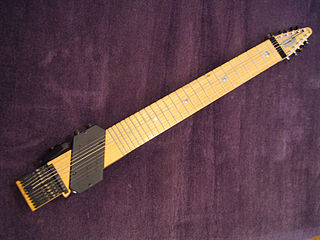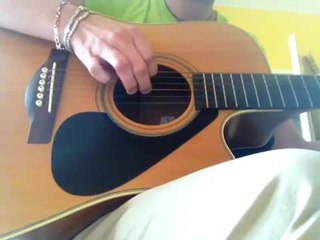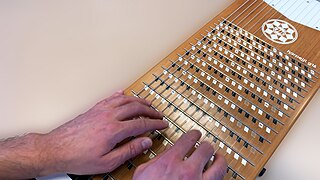
String instruments, stringed instruments, or chordophones are musical instruments that produce sound from vibrating strings when a performer plays or sounds the strings in some manner.

Zithers are a class of stringed instruments. Historically, the name has been applied to any instrument of the psaltery family, or to an instrument consisting of many strings stretched across a thin, flat body. This article describes the latter variety.

The Chapman Stick is an electric musical instrument devised by Emmett Chapman in the early 1970s. A member of the guitar family, the Chapman Stick usually has ten or twelve individually tuned strings and is used to play bass lines, melody lines, chords, or textures. Designed as a fully polyphonic chordal instrument, it can also cover several of these musical parts simultaneously.

Tapping is a playing technique that can be used on any stringed instrument, but which is most commonly used on guitar. The technique involves a string being fretted and set into vibration as part of a single motion. This is in contrast to standard techniques that involve fretting with one hand and picking with the other. Tapping is the primary technique intended for instruments such as the Chapman Stick.

Emmett Chapman was an American jazz musician best known as the inventor of the Chapman Stick and maker of the Chapman Stick family of instruments.
The NS/Stick is an 8 string tapping instrument designed by Emmett Chapman and Ned Steinberger. It incorporates design ideas from both the original Stick and from Ned Steinberger's instruments such as the Stick's tapping fretboard and the Steinberger Bass' knee bar and headless design. The player can position the instrument upright for tapping or lower it to a horizontal position for picking, slapping, or strumming.
Tapboard is the name of two separate guitar-based instruments that employ variations of the tapping technique. One of these is played by guitarist Francis Dunnery and the other by bassist Balazs Szendofi. Unlike other tapping instruments such as the Chapman Stick, harpejji and Warr Guitar, both Tapboards are one-off custom designs and have never been produced commercially.

A flamenco guitar is a guitar similar to a classical guitar but with thinner tops and less internal bracing. It usually has nylon strings, like the classical guitar, but it generally possesses a livelier, more gritty sound compared to the classical guitar. It is used in toque, the guitar-playing part of the art of flamenco.

There are many varieties of ten-string guitar, including:
The Megatar is a stringed musical instrument designed to be played using a two-handed tapping technique. It is manufactured by the American company Mobius Megatar.

Free Hands is the name of Emmett Chapman's two-handed tapping method of parallel hands used on his Chapman Stick instrument, and on several other Stick-inspired instruments. Chapman first published his tapping lessons in book form in 1976, and called his method book Free Hands: A New Discipline of Fingers on Strings.
This is a chart of stringed instrument tunings. Instruments are listed alphabetically by their most commonly known name.
String instruments are capable of producing a variety of extended technique sounds. These alternative playing techniques have been used extensively since the 20th century. Particularly famous examples of string instrument extended technique can be found in the music of Krzysztof Penderecki, Witold Lutosławski, George Crumb, and Helmut Lachenmann.

Guitar picking is a group of hand and finger techniques a guitarist uses to set guitar strings in motion to produce audible notes. These techniques involve plucking, strumming, brushing, etc. Picking can be done with:

The StarrBoard is a stringed musical instrument invented by John D. Starrett and patented on July 23, 1985.

The touch guitar is a stringed instrument of the guitar family which has been designed to use a fretboard-tapping playing style. Touch guitars are meant to be touched or tapped, not strummed.

Experimental luthiers are luthiers who take part in alternative stringed instrument manufacturing or create original string instruments altogether.

The harpejji ( har-PEJ-ee) is an electric stringed musical instrument developed in 2007 by American audio engineer Tim Meeks. It can be described as a cross between a piano and a guitar, or as a cross between an accordion and a pedal steel guitar. The playing surface has a layout arranged in ascending whole tones across strings, and ascending semi-tones as the strings travel away from the player with a five octave range from A0 to A5. Harpejjis use an electronic muting system to dampen unfretted strings and minimize the impact of sympathetic vibrations.

The Warr Guitar is an American-made touch guitar, a type of instrument that combines both bass and melodic strings on a single fretboard. It is related to the Chapman Stick, another two-handed tapping instrument. The Warr guitar is designed for either two-handed tapping or strumming. Warr guitars have between seven and 14 strings.

The tube zither is a stringed musical instrument in which a tube functions both as an instrument's neck and its soundbox. As the neck, it holds strings taut and allows them to vibrate. As a soundbox or it modifies the sound and transfers it to the open air. The instruments are among the oldest of chordophones, being "a very early stage" in the development of chordophones, and predate some of the oldest chordophones, such as the Chinese Se, zithers built on a tube split in half. Most tube zithers are made of bamboo, played today in Madagascar, India, Southeast Asia and Taiwan. Tube zithers made from other materials have been found in Europe and the United States, made from materials such as cornstalks and cactus.
This page is based on this
Wikipedia article Text is available under the
CC BY-SA 4.0 license; additional terms may apply.
Images, videos and audio are available under their respective licenses.












